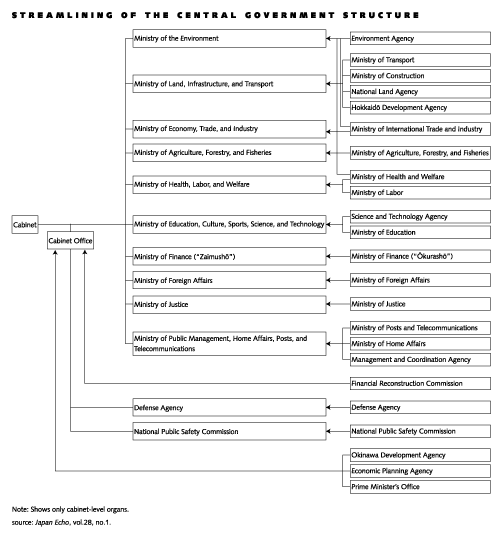









 |
 |
Business & Economy |  |
Science & Technology |  |
Education & Society |  |
Sports & Fashion |  |
Arts & Entertainment |
 |
 |
Top Picks |  |
Back Numbers |  |
Search |
| REVAMPING GOVERNMENT: Central Bureaucracy Undergoes Reform February 1, 2001 Fresh from the first major reforms in 50 years, the newly restructured government of Japan began work on January 6. The centerpiece of the reform effort is the creation of a Cabinet Office, which will enable quicker, more effective responses to complicated policy issues. The 22 former ministries and agencies and the Prime Minister's Office have been integrated into 12 ministries and the new Cabinet Office to attain smoother administration. The Cabinet Office has a supraministerial role, providing a framework through which the ministries can work together in implementing policies. With the revamped system, the government hopes to better meet people's needs and steer a new course for the nation. Compact Administration Reorganization involved integrating ministries and agencies which had overlapping or complementary functions. The Ministry of Posts and Telecommunications, the Ministry of Home Affairs, and the Management and Coordination Agency have combined to form the Ministry of Public Management, Home Affairs, Posts, and Telecommunications. The Ministry of Education and the Science and Technology Agency have joined to form the Ministry of Education, Culture, Sports, Science, and Technology. The Ministry of Health and Welfare and the Ministry of Labor have merged to form the Ministry of Health, Labor, and Welfare. The new Ministry of Land, Infrastructure, and Transport is a consolidation of four previous agencies and ministries: the Ministry of Transport, the Ministry of Construction, the National Land Agency, and the Hokkaido Development Agency. The Economic Planning Agency and the Okinawa Development Agency, which had previously reported to the Prime Minister's Office, have been absorbed into the Cabinet Office. And the Environment Agency has been upgraded to ministry status as the Ministry of the Environment. Of the seven other ministries, two have changed their names in line with their expected duties under the new system: While the Ministry of the Finance retains its English name, its Japanese name has changed from Okurasho to Zaimusho; and the Ministry of International Trade and Industry has been renamed the Ministry of Economy, Trade, and Industry. A More Efficient Administration Another goal is streamlining. In addition to simplifying the bureaucratic structure, a reduction in staff is also a key target. Excluding postal workers, the number of public employees currently stands at about 550,000. The current staff will be reduced by 25% over the next 10 years through streamlining and the introduction of independent administrative institutions, which will absorb public employees when they take over the management of museums, research institutes, and other public institutions. The third goal is achieving greater openness and transparency. In the past, once a project, such as dam or harbor construction, began, it was rarely reevaluated or inspected for potential improvements, and the system was not very responsive to the wishes of citizens. Now, a two-layered system has been established to objectively assess projects or policies that are already in place, and based on these assessments, projects or policies may be revised. First, each ministry will set up a committee to undertake internal evaluations. These activities will then be reviewed by the Administrative Evaluation Bureau in the Ministry of Public Management, Home Affairs, Posts, and Telecommunications. The minister of public management, home affairs, posts, and telecommunications has the authority, moreover, to recommend improvements where they are deemed necessary. And to ensure openness, the Freedom of Information Law enacted in May 1999 will obligate the government to explain policy to the public. The law goes into effect in April 2001. 
|